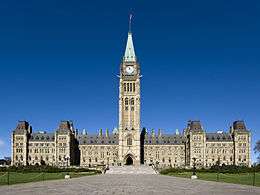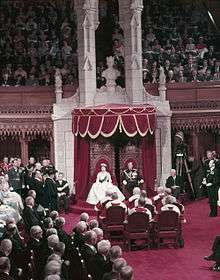Opening of the Canadian parliament

The opening of the Canadian parliament is the commencement of a session of the Parliament of Canada following a general election. It involves summons from the governor general on behalf of the Queen of Canada and a ceremony based on the same in the United Kingdom, though less elaborate and now evolved to include uniquely Canadian elements.
Summons
At the same time as the Governor General of Canada drops the writ for a federal election, he or she also issues a royal proclamation summoning parliament—setting the date for the opening of the next parliament following the election (though, the date may be amended by subsequent proclamations, so long as parliament eventually meets as required by the Constitution Act, 1867).[1] These read as follows:
TO ALL WHOM these Presents shall come or whom the same may in any way concern,Greeting:
A proclamation
Whereas We are desirous to meet Our People of Canada as soon as may be and to have their advice in Parliament;
We do hereby, by and with the advice of Our Prime Minister of Canada, summon and call together the House of Commons of Canada, to meet at Our City of Ottawa, on [date], then and there to have conference and treaty with the Senate of Canada.[1]
A later proclamation gives the precise time for parliament to open:
To Our beloved and faithful SENATORS of Canada, and MEMBERS elected to serve in the House of Commons of Canada, and to all whom these Presents may in any way concern,Greeting:
A proclamation
Whereas Our Parliament of Canada was dissolved on [date];
Therefore We, by these Presents, command each of you and all others interested in this behalf to appear in person on [date], at [time] at Our City of Ottawa, for the DISPATCH OF BUSINESS, to treat, do, act, and conclude upon those things that Our Parliament of Canada may, by the Grace of God, ordain.[2]
Of the governor general's deputies, only the justices of the supreme court can summon parliament (though they, nor the other deputies, may dissolve it).[1]
Opening of parliament

Canada has two types of opening for the federal parliament, differentiated by scale: Larger openings, called bench openings, require the seating of the Senate (where the monarch, governor general, or another delegate reads the Throne Speech) is rearranged to accommodate the number of official guests—the justices of the supreme court, lieutenant governors, former prime ministers, members of the Queen's Privy Council for Canada, and members of the diplomatic corps, and any spouses—and the galleries are reserved for other guests. Smaller openings, called desk openings do not require the removal of senators' desks, as guests are limited to the justices of the supreme court, invitees of the governor general and prime minister, and the deans of the diplomatic corps. The Speaker of the Senate establishes the guest list, though the size of the ceremony is determined by the prime minister.[3]
The opening of the first session of a parliament takes place over two days (the opening of a subsequent session of the same parliament requires only one day[4]). On the first, routine business is conducted. After such is concluded, the Speaker of the Senate commands the Usher of the Black Rod (Black Rod) to summon the members of the House of Commons to the Senate. Once assembled, the speaker addresses the congregation, stating "Honourable Members of the Senate, Members of the House of Commons: I have it in command to let you know His [or Her] Excellency the Governor General does not see fit to declare the causes of his [or her] summoning of the present Parliament of Canada, until a Speaker of the House of Commons shall have been chosen, according to law; but tomorrow, [date], at [time], His [or Her] Excellency will declare the causes of his [or her] calling this parliament." The Members of Parliament then return to the commons to elect the speaker for that chamber. The speech itself is delivered the following day.
As the Queen's representative, the governor general attends parliament to deliver the Speech From the Throne, although this can and has been done by the sovereign themselves or another representative, for example the Queen gave the Speech from the Throne in 1977.[5] Accompanied by four officers of the Royal Canadian Mounted Police, he or she usually rides in the State Landau, often accompanied by the viceregal consort, between Rideau Hall and Parliament Hill, where the governor general inspects a Canadian Armed Forces guard of honour.[6] Once the viceroy is in the parliament building, the Usher of the Black Rod is again sent to call the members of the House of Commons to the Senate. Upon his or her arrival at the bar of the Senate, the Speaker of the House of Commons addresses his counterpart in the Senate, asserting the rights and privileges of the commons and its members. The Speaker of the Senate, on behalf of the governor general, responds that the Crown will "recognise and allow their constitutional privileges." The governor general then reads the Throne Speech,[7] during which the Senate's mace is held by the Mace Bearer, who stands to the side of the throne.[8]
Debate
The address is followed by a debate and vote in both houses of parliament. Formally, the motion merely calls on parliament to thank the monarch or viceroy for the speech via an Address in Reply. Until 1897, this was a more detailed message, covering the content of the Throne Speech point by point.[9] Today, in the Senate, takes the form of simply:
That the following Address be presented to His [or Her] Excellency the Governor General of CanadaTo His [or Her] Excellency the Right Honourable [name], Chancellor and Principal Companion of the Order of Canada, Chancellor and Commander of the Order of Military Merit, Chancellor and Commander of the Order of Merit of the Police Forces, Governor General and Commander-in-Chief of Canada.
MAY IT PLEASE YOUR EXCELLENCY:
We, Her [or His] Majesty's most loyal and dutiful subjects, the Senate of Canada in Parliament assembled, beg leave to offer our humble thanks to Your Excellency for the gracious Speech which Your Excellency has addressed to both Houses of Parliament.[9]
The debate is, however, often wide-ranging, exploring many aspects of the government's proposed policies, and spread over several days. When the Address in Reply is eventually voted on, the poll is held to constitute a motion of confidence in the government, which, if lost, would result in the end of that government's mandate.[10] This discussion and vote follows a symbolic raising of other matters, designed to highlight the independence of parliament from the Crown; a practice that originated after King Charles I was tried and executed by the Parliament of England.[11] In the Senate, it is Bill S-1, an Act Relating to Railways.[12]
See also
References
- 1 2 3 Senate of Canada (June 2015), Senate Procedure and Practice (PDF), Ottawa: Queen's Printer for Canada, p. 40, retrieved 15 November 2015
- ↑ Senate of Canada 2015, p. 41
- ↑ Senate of Canada 2015, pp. 41-42
- ↑ Senate of Canada 2015, p. 45
- ↑ "Speech from the Throne Infographic" (Press release). Her Majesty the Queen in Right of Canada. 2015. Retrieved 3 December 2015.
- ↑ "Delivering the government's blueprint". CBC. 12 November 2008. Retrieved 20 November 2015.
- ↑ Senate of Canada 2015, p. 42
- ↑ Senate of Canada 2015, p. 43
- 1 2 Senate of Canada 2015, p. 44
- ↑ House of Commons Library (September 2008), "Parliamentary Elections" (PDF), Factsheet M7, Queen's Printer, p. 3, ISSN 0144-4689, archived from the original (PDF) on 25 March 2009, retrieved 19 November 2009
- ↑ Woods, Henrik (2011), "My Lords and Gentlemen": A Study of British Origins and the Evolution of the Canadian Throne Speech Genre (PDF), Library and Archives Canada, p. 6, retrieved 30 September 2015
- ↑ "Debates of the Senate, 2nd Session, 39th Parliament". Hansard. Ottawa: Queen's Printer for Canada. 144 (1). 16 October 2007. Retrieved 2 December 2009.